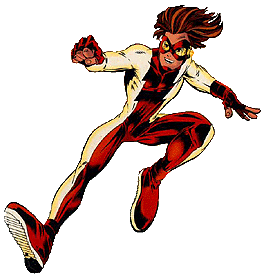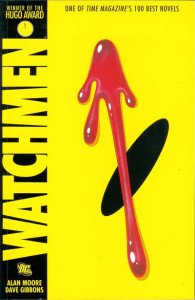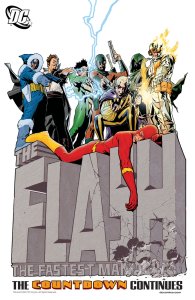I read Infinite Crisis #2 today, and everything—including DC’s turn toward the dark over the past few years—is starting to make sense. Infinite Crisis isn’t just following up on plotlines from Crisis on Infinite Earths, it’s actually making a statement about the past 20 years of comics.
Potential spoilers ahead! Remember the grim-n-gritty period in the 1980s? The ultra-violent period in the 1990s? Remember when Superman was killed, Batman’s back was broken, and Wonder Woman was replaced? Remember when Green Lantern turned evil and tried to destroy the universe?
The dark tone that has pervaded the DCU since Identity Crisis is all about following those trends to their conclusion. Infinite Crisis isn’t just about dark events hitting the DCU, it’s about the DCU becoming its darkest.
The premise of IC seems to be that something has gone fundamentally wrong with the universe. It’s become corrupted. Like making a meal out of spoiled ingredients, things turn out wrong. And you get discord. You get heroes who are barely better than the villains they fight. You get conflicts that don’t make sense, because the universe itself is broken.
At least one character thinks that the original Crisis ended wrong. Instead of realigning the universe around Earth-1, it should have been realigned around Earth-2. This actually makes sense, in terms of the history of comics, since Earth-2 grew out of the first 15 years that DC published, and Earth-1 came much later.
So the stage is set. One group of heroes, led by Earth-2’s Superman—though I suspect Power Girl may take over at some point—wants to realign the universe. One group, led by Donna Troy, wants to repair it. Hmm, two multiverse refugees, on opposing sides. You can bet they’ll come into conflict, though you do have to wonder—which side is right? Is the modern DCU worth saving?
And would DC actually move to a model where Supes, Bats and Wonder Woman fought in World War II, and the modern heroes are their successors?



Personally, I’m hoping…..not, as I’m too used to how things are now, plus It’d kinda make supes, bats, and WonW,way too patriotic, for my taste. So I’m kinda rootin for Donna’s posse.
But yeah, I can see your point modern DCU has gotten a lot darker through the years,……… but I like it that way.
It’d be funny if the only reality that actually survives through this/resurfaces, is Earth-prime’s superboy.
If the world is rebuilt around the Earth 2 characters how will that affect things that are happening in the Seven Soldiers miniseries? It is even more grim and foreboding than the events occuring in Infinite Crisis and its tie-ins. Can we have two Supermen, two Superboys, etc, etc.? What is going to be the final outcome? The only way to know for sure is to keep on reading. But keep on guessing because speculation is such great fun.
I’ve heard a lot of people speculate that Seven Soldiers takes place in the post-IC universe. Considering that it’s stayed away from the big guns as much as possible—Zatanna and Mr. Miracle are the most prominent characters it’s used—there really isn’t a way to tell. But DC does seem to have planned things far enough ahead that they could pull it off, particularly with Grant Morrison as one of the main architects of the new DCU…
Roy Thomas had the right idea over twenty years ago, but they ripped the rug out from under him long before Crisis on Infinite Earths began. Thomas started All-Star Squadron as a way of retelling the golden age tales with a modern sensibility. However, as was the case in the golden age with All Star comics, characters like Superman, Batman, and Wonder Woman couldn’t be featured in the forefront, because they didn’t wanna contradict the already ongoing franchises. This caused Thomas to dance a bit, and the end result allowed other characters like Liberty Belle and Hawkman to shine in the spotlight, but it also placed limits on Thomas’ storytelling options. Then after Crisis the incongruity of resetting The Big Three in the present instead of the past caused the early issues of All-Star Squadron to contadict itself while it was still a viable title, thus helping it lose it’s viability and credibility. Damn shame. It had been a lot of fun.
What the editors (of the Silver Age) should have done from the beginning is accept that Superman, Batman, and Wonder Woman’s stories have always belonged in the mid twentieth century, through world war two and on into the McCarthy era, but by the 70s they should have started showing their age, and by now they should be fond memories. There should never have been an “Earth-1” (how erroneous a nomenclature), and I see all this Infinite Crisis silliness being a continuing refusal to accept the inevitable – there’s only one way for there to be a happy ending.
However, from an editorial (and more importantly economic) standpoint, making a DCU without conflict would destroy their trademarks. The people behind DCs intellectual properties want to insure that the stories of their big name characters will forever be fresh and new, in which case they should abandon continuity altogether.
The stories DC should be telling today are new ones with new characters and modern settings. Setting Batman in today’s America is like setting Sherlock Holmes in today’s England. It might sell books, but it doesn’t make common sense. Of course, who would possibly want to tell stories in a universe that made any sense? Where’s the fun in that?
For the rest of you who still buy comics, in a medium where every twenty-eight pages has to end in a cliffhanger, in order to keep the revenue flowing in, there’s no room for happy endings that last. For me? As far as I’m concerned, 1986 was the end of the line. I invented my own issue twelve of Crisis on Infinite Earths in my head. In my version, everyone lived happily ever after. Even Guy Gardner.